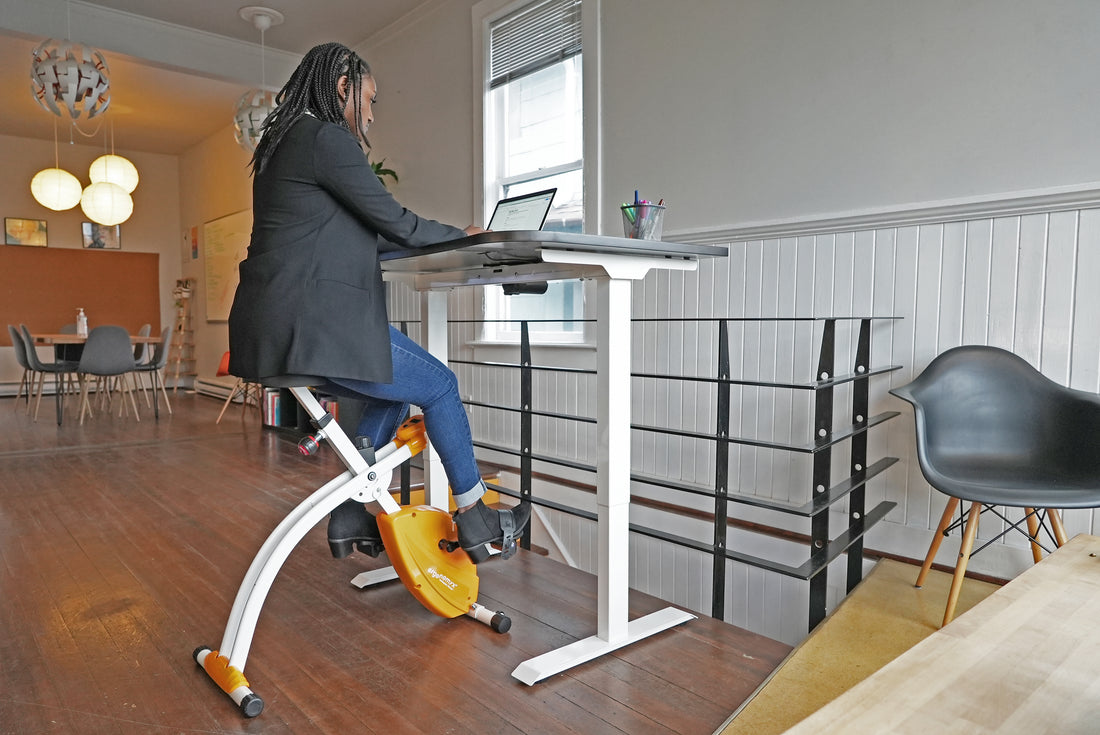Why You Don't See a Moving Workspace as Important - And Why You're Wrong
September 14th, 2021
Did you know that how you make a living can also be detrimental to your health?
It’s true. Many people who work exclusively behind a desk are at risk of long-term health problems. Sitting for eight hours a day isn’t only inactive - increasing research shows that it is dangerous, and could affect the longevity of your life.
The problem is that our world is built for sitting. We don’t just sit during work hours, but also at home while we relax, and in the car during our commute, and so many other areas of our lives. It can be hard to keep yourself moving when your eight hours at work are spent sitting in the same position, and then your off-time is spent sitting as well.
So how long are people sitting during the day? Studies show that the average adult in the United States sits for about 7.7 hours a day. That’s almost half your day! This is especially concerning, because studies also show that it only takes twenty minutes of uninterrupted sitting to start inhibiting your metabolism. Inhibited metabolism can lead to more health problems, including obesity, diabetes, and can as much as double the risk of heart disease.
Those aren’t the only risks of leading a sedentary lifestyle. A sedentary lifestyle can also lead to high blood pressure, a less functional immune system, and lost muscle mass. It can also increase the risk of cancer and osteoporosis.
And those are just the physical effects. It also affects your mental health - studies have shown that people who lead sedentary lifestyles are more likely to develop depression and anxiety.
Now, take this into consideration: according to the World Health Organization, 60-85% of the world’s population lead sedentary lifestyles. This makes it a public health problem. Yet, there are few solutions being created to solve it.
Part of the problem is that people aren’t wired to see this as a problem worth solving! Back in our history, when we were hunter-gatherers, being active was a built-in part of life - most able-bodied people were regularly keeping active in order to feed themselves. As a result, we evolved to store energy as much as possible. And we don’t like to expend energy for no reason, because our bodies see this as a waste of energy that we could be using to hunt, or flee from predators. In a way, it goes against our nature to keep moving with no life-sustaining reason to. Evolutionarily, having a lot of time to sit isn’t a problem, it’s the dream!
So humans are wired to stay lazy. But now that programming is working against us. Our bodies want to store energy, but we aren’t actually built to stay still for extended periods of time. As a result, we over-store calories and energy that we don’t use.
And that’s another thing that makes this problem more difficult to overcome. Our bodies don’t want us to solve the problem, despite the fact that it can lead to long-term health problems.
That can be some of the reason it’s so difficult to form a fitness habit. That said, forming any kind of habit is difficult, regardless of what it is.
Forming a habit consists of three parts: the cue, the action, and the reward. This is why it’s so easy to form unhealthy habits. When it comes to forming the habit of something bad for you - for example, let’s say, eating unhealthy food - the process goes:
1. The Cue - one feels stressed.
2. The action - one eats unhealthy fast food.
3. The reward - one temporarily enjoys eating something fast, easy, and tasty, with little effort.
This pattern makes it difficult to form healthier habits, as it’s harder to create an environmental cue that triggers the brain to do something healthy. One would have to deliberately put something in their environment that will trigger the desire to exercise.
As for the reward component, you might have heard that exercising releases pleasant endorphins during and after. This is true, but first your brain has to get used to doing exercise again. In other words, this won’t happen right away! That’s another detriment to forming a fitness habit, unfortunately: if you don’t provide yourself with a reward externally, then there’s often no immediate reward for the hard work.
Something else that makes it difficult to exercise regularly is simply that there isn’t enough time in the day. If the average person works eight hours a day, commutes to and from work, has to do some errands, makes themself dinner, and indulges in some well-deserved relaxation, at what point do they decide to go and work out?
Recent studies have shown that the average amount of free time adults get in a week is shockingly low, with one study reporting an average of only four hours and twenty-six minutes of free time per week. That doesn’t leave much time to exercise during the week!
It helps to stay motivated and keep the habit of fitness going if one has someone to work out with. Studies show that having a community, or even just a workout buddy, makes you work harder and more often. But how can you find someone to work out with, when all your peers have as little free time as you?
With all this in mind, it’s no wonder that a third of the population is inactive. Finding the time and motivation to stay active isn’t easy!
The secret to staying active despite all these obstacles could be those eight hours spent at work. That’s the time when people spend the most time sitting in a fixed position. There are a few recommendations about how to spend that time at work. One study says you should spend thirty minutes sitting, twenty minutes standing, and ten minutes moving in the space of an hour. Another study says you should spend twenty minutes sitting, eight minutes standing, and two minutes moving in the space of a half hour. It’s hard to say for sure, as all these studies are new.
But what is certain is that it isn’t enough even to just sit and stand - one needs to be sitting, standing, and moving, in order for your work to not do damage to your body.
We had all this in mind when we designed our Workspace Fitness devices. That’s why we not only have the Smart Sit-and-Stand Desk, but the Smart Under-the-Desk Bike as well.
The Smart Under-the-Desk Bike allows you to move, as well as sit and stand, without even having to leave your desk. It’s there to help you on your fitness journey and help you get in the habit of being active!
With the bike, it’s easy to form a habit, because the cue and the reward are both there. For example:
1. The Cue - logging into work that morning.
2. The action - pedaling on the bike.
3. The reward - do something fun after work instead of working out!
The bike also has a gamification element. You can compete with your colleagues and friends to see who pedals the most. This will help in building your habit of being active, as you’re motivated not just internally, but by friendly competition with other people in your network.
It can also help you in your fitness journey in other ways - for instance, the bike will track the distance you’ve pedaled, and the number of calories burned, as well as other metrics. This way, you’re never unsure of how much you’ve done.
It’s convenient to use, as well. It can be folded up to fit in a small space when not in use, has a comfortable seat to sit on while working, and doesn’t even use electricity! Instead, it uses an energy self-harvesting battery, meaning it takes energy from your pedalling. It’s convenient, sustainable, and keeps you healthy and moving.
Even though the dangers of a sedentary life are one of the greatest risks to the population right now, there aren’t a lot of solutions out there to help keep these risks at bay - and many of the suggested solutions don’t take into account the reasons staying active is difficult. Our Smart Under-the-Desk Bike takes into account those difficulties, and not only makes it possible to lead a healthier life, but makes it easier.
“I love the Smart Under-the-Desk Bike! In a world where many of us get far too little exercise, the bike is an amazing solution - particularly since I have been working from home since March, 2020 (due to the global, coronavirus pandemic). As a busy parent in a family of four who works full-time, combining an element of daily physical activity while at working at my desk/computer is an incredible efficiency!”
- Janice N.
“I love it! It is an exercise bike very easy to assemble, it takes up very little space, not only can it be used with the desk, but I also use it to exercise while watching television at home.”
- Natalie S.
“Great purchase! The bike has a smooth pedal and is very quiet. Easy to see my progress using the screen or app. Comfortable seat. Thanks for helping me find healthy movement in my work day!”
- Shireen B.
“I am really pleased with my Ergonomyx desk bike. It is easy to move so that I can shift between standing and cycling. The mechanism makes very little noise so I can use it while I am on videoconference meetings. And, I can cycle steady for long periods of time. I am tall and found the Ergonomyx team really helpful in sending me an extension package. I look forward to logging many kilometres this coming winter. This is a great idea and Ergonomyx has made a great product. Thank you.”
- Marisha R.

